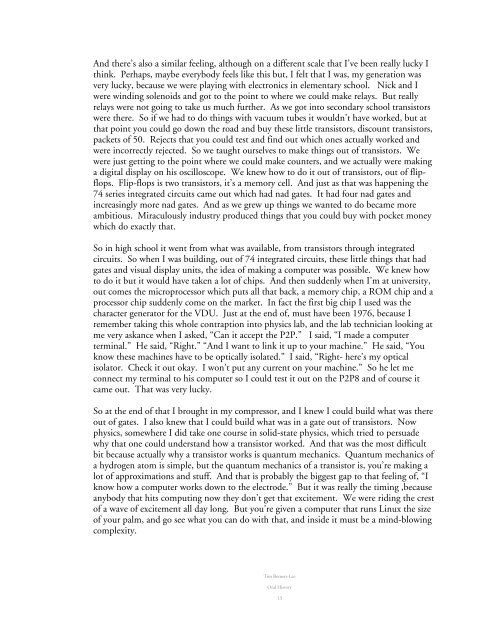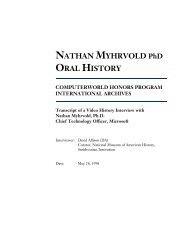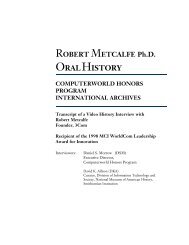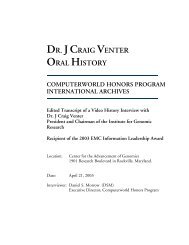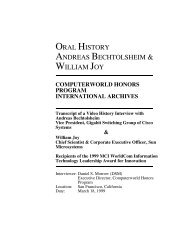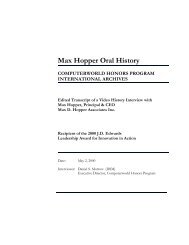My name is Craig Conway - The Computerworld Honors Program
My name is Craig Conway - The Computerworld Honors Program
My name is Craig Conway - The Computerworld Honors Program
You also want an ePaper? Increase the reach of your titles
YUMPU automatically turns print PDFs into web optimized ePapers that Google loves.
And there’s also a similar feeling, although on a different scale that I’ve been really lucky I<br />
think. Perhaps, maybe everybody feels like th<strong>is</strong> but, I felt that I was, my generation was<br />
very lucky, because we were playing with electronics in elementary school. Nick and I<br />
were winding solenoids and got to the point to where we could make relays. But really<br />
relays were not going to take us much further. As we got into secondary school trans<strong>is</strong>tors<br />
were there. So if we had to do things with vacuum tubes it wouldn’t have worked, but at<br />
that point you could go down the road and buy these little trans<strong>is</strong>tors, d<strong>is</strong>count trans<strong>is</strong>tors,<br />
packets of 50. Rejects that you could test and find out which ones actually worked and<br />
were incorrectly rejected. So we taught ourselves to make things out of trans<strong>is</strong>tors. We<br />
were just getting to the point where we could make counters, and we actually were making<br />
a digital d<strong>is</strong>play on h<strong>is</strong> oscilloscope. We knew how to do it out of trans<strong>is</strong>tors, out of flipflops.<br />
Flip-flops <strong>is</strong> two trans<strong>is</strong>tors, it’s a memory cell. And just as that was happening the<br />
74 series integrated circuits came out which had nad gates. It had four nad gates and<br />
increasingly more nad gates. And as we grew up things we wanted to do became more<br />
ambitious. Miraculously industry produced things that you could buy with pocket money<br />
which do exactly that.<br />
So in high school it went from what was available, from trans<strong>is</strong>tors through integrated<br />
circuits. So when I was building, out of 74 integrated circuits, these little things that had<br />
gates and v<strong>is</strong>ual d<strong>is</strong>play units, the idea of making a computer was possible. We knew how<br />
to do it but it would have taken a lot of chips. And then suddenly when I’m at university,<br />
out comes the microprocessor which puts all that back, a memory chip, a ROM chip and a<br />
processor chip suddenly come on the market. In fact the first big chip I used was the<br />
character generator for the VDU. Just at the end of, must have been 1976, because I<br />
remember taking th<strong>is</strong> whole contraption into physics lab, and the lab technician looking at<br />
me very askance when I asked, “Can it accept the P2P.” I said, “I made a computer<br />
terminal.” He said, “Right.” “And I want to link it up to your machine.” He said, “You<br />
know these machines have to be optically <strong>is</strong>olated.” I said, “Right- here’s my optical<br />
<strong>is</strong>olator. Check it out okay. I won’t put any current on your machine.” So he let me<br />
connect my terminal to h<strong>is</strong> computer so I could test it out on the P2P8 and of course it<br />
came out. That was very lucky.<br />
So at the end of that I brought in my compressor, and I knew I could build what was there<br />
out of gates. I also knew that I could build what was in a gate out of trans<strong>is</strong>tors. Now<br />
physics, somewhere I did take one course in solid-state physics, which tried to persuade<br />
why that one could understand how a trans<strong>is</strong>tor worked. And that was the most difficult<br />
bit because actually why a trans<strong>is</strong>tor works <strong>is</strong> quantum mechanics. Quantum mechanics of<br />
a hydrogen atom <strong>is</strong> simple, but the quantum mechanics of a trans<strong>is</strong>tor <strong>is</strong>, you’re making a<br />
lot of approximations and stuff. And that <strong>is</strong> probably the biggest gap to that feeling of, “I<br />
know how a computer works down to the electrode.” But it was really the timing ,because<br />
anybody that hits computing now they don’t get that excitement. We were riding the crest<br />
of a wave of excitement all day long. But you’re given a computer that runs Linux the size<br />
of your palm, and go see what you can do with that, and inside it must be a mind-blowing<br />
complexity.<br />
Tim Berners-Lee<br />
Oral H<strong>is</strong>tory<br />
13


